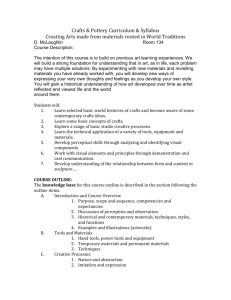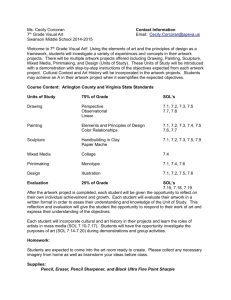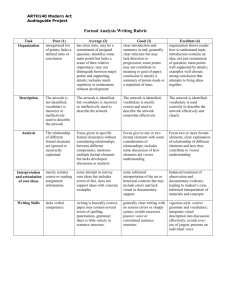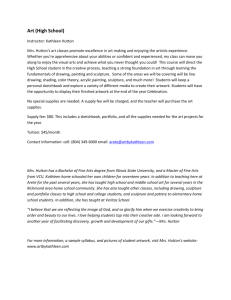Three Dimensional (3D) Concepts
advertisement
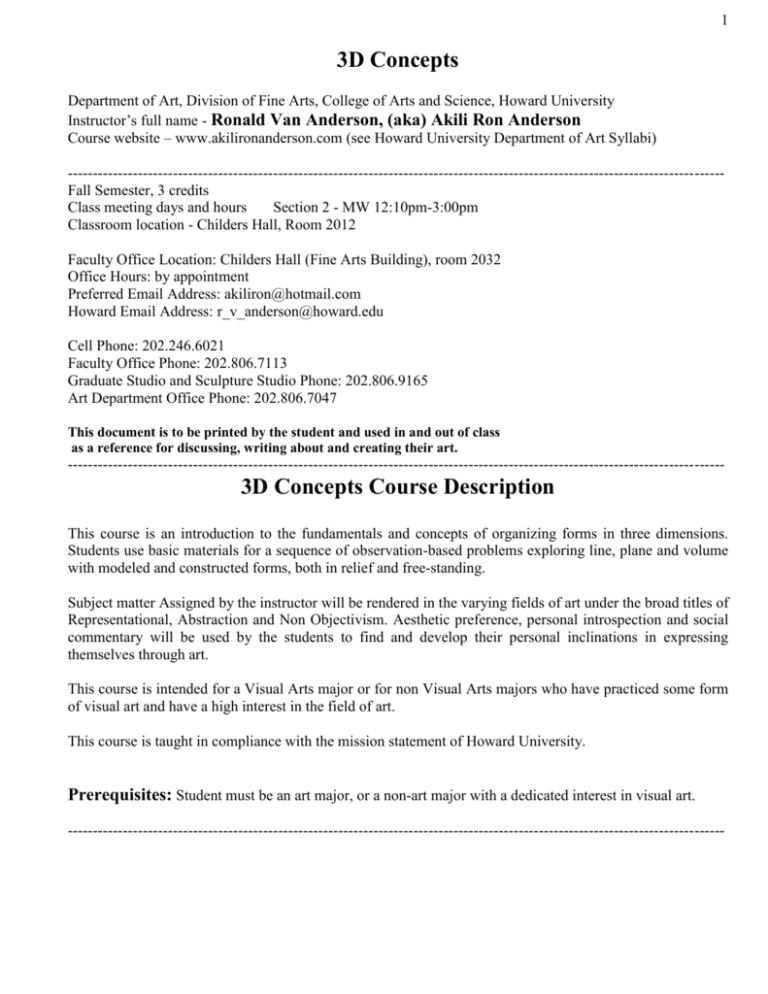
1 3D Concepts Department of Art, Division of Fine Arts, College of Arts and Science, Howard University Instructor’s full name - Ronald Van Anderson, (aka) Akili Ron Anderson Course website – www.akilironanderson.com (see Howard University Department of Art Syllabi) ----------------------------------------------------------------------------------------------------------------------------------Fall Semester, 3 credits Class meeting days and hours Section 2 - MW 12:10pm-3:00pm Classroom location - Childers Hall, Room 2012 Faculty Office Location: Childers Hall (Fine Arts Building), room 2032 Office Hours: by appointment Preferred Email Address: akiliron@hotmail.com Howard Email Address: r_v_anderson@howard.edu Cell Phone: 202.246.6021 Faculty Office Phone: 202.806.7113 Graduate Studio and Sculpture Studio Phone: 202.806.9165 Art Department Office Phone: 202.806.7047 This document is to be printed by the student and used in and out of class as a reference for discussing, writing about and creating their art. ----------------------------------------------------------------------------------------------------------------------------------- 3D Concepts Course Description This course is an introduction to the fundamentals and concepts of organizing forms in three dimensions. Students use basic materials for a sequence of observation-based problems exploring line, plane and volume with modeled and constructed forms, both in relief and free-standing. Subject matter Assigned by the instructor will be rendered in the varying fields of art under the broad titles of Representational, Abstraction and Non Objectivism. Aesthetic preference, personal introspection and social commentary will be used by the students to find and develop their personal inclinations in expressing themselves through art. This course is intended for a Visual Arts major or for non Visual Arts majors who have practiced some form of visual art and have a high interest in the field of art. This course is taught in compliance with the mission statement of Howard University. Prerequisites: Student must be an art major, or a non-art major with a dedicated interest in visual art. ----------------------------------------------------------------------------------------------------------------------------------- 2 Course goals (What do you want to achieve?) 1. This course will develop the student’s foundational cognitive and creative skills in viewing, analyzing and rendering in three dimensions. 2. The student will develop visual organization skills (sequential steps for creating artwork). 3. The student will develop the ability to literally and abstractly interpret forms. 4. The student will be encouraged to produce a visual sense of style in their work. 5. The student will structure the processes for articulating aesthetic ideas. 6. The student will cultivate a critical vocabulary to promote the ability to defend their opinions. Course objectives (What will students be able to do, be, possess, or perceive when each goal is attained?) 1. The student will be able to utilize the basic elements and principles of three dimensional art for their associated studies. 2. The student will develop an understanding and appreciation of the interaction of form in space and the ways to manipulate it. 3. The student will develop abilities in perception, conception, creative problem-solving, decisionmaking, risk-taking, and personal expression through a series of related assignments which respect tradition and encourage innovation. 4. The student will develop useful attitudes towards creative activity. 5. To develop a sensitivity to a wide range of 3D media, processes, and concepts by exploring their possibilities and limitations. 6. The student will produce a series of 3D designs that demonstrate significant growth in all of the above. 7. The student will be qualified to enroll in advanced sculpture classes. 8. The student will have the skills and confidence to continue their creative career. Course Requirements 1. 2. 3. 4. 5. 6. (What performance criteria must students meet to fulfill the objectives?) The student must complete all assignments. The student must use aesthetic language to discuss their work. The student must demonstrate an enthusiasm in performing their work. The student must be able to articulate their progress and the value of their work. The student must have a vision for their career in the arts. The student must attend classes on time and for the full time. ----------------------------------------------------------------------------------------------------------------------------------- 3 COURSE CONTENT: 3D Fundamentals: Studio sessions will consist of a sequence of projects that will introduce the visual and verbal vocabulary and concepts of 3-Dimensional design: primarily line, plane, volume, mass, space, texture, scale, time, and context. These will be supplemented by readings, handouts, slide lectures, demonstrations, informal discussions, individual and group critiques, quizzes, and research projects on individual artists. Creative Problem-Solving: Each project will include a discussion of the acceptance and definition of the problem, ideation, and judgment, and conceptualization through sketching and possibly model-making. 3D Processes: Projects will incorporate planar, linear, and volumetric construction techniques. These will introduce the elements of form and function, and the intrinsic and expressive qualities of different materials. 3D Media: Projects will explore these materials: card, wire, wood, screen and found objects. Themes: Projects will include 3D studies of everyday objects, the human figure, forms from nature and technology, and personal themes interpreted by representation or abstraction. Drawing/ Sketchbook Component: Students must spend time inside and outside class keeping a small sketchbook, a "visual notebook" for the duration of the class. This sketchbook is to be used exclusively for this class. The importance of using a sketchbook cannot be emphasized enough. The sketchbook is a tool for the development of ideas, and an aid to visual thinking: before, during, and after each project. It should be brought to all classes and used constantly to record ideas, explore solutions, variations, new relationships, contrasts, structural problems, and art historical influences. Writing/ Research: Students may be asked to write brief statements on their projects as a form of selfevaluation. Critiques: Group critiques will be held at the end of each project, and during each project as a "work-inprogress" discussion. Individual critiques will be held at mid-semester and at the end of the semester. Students can request an appointment for an individual critique at any time that is mutually agreeable. Students are expected to complete projects on time and to participate fully in group discussions and critiques. These critiques are especially important and are part of the learning, evaluation, and analysis process. They are the equivalent of an exam. Students are expected to be there with their completed projects. Photography: Because of the physical size of these 3D projects, digital or color slide documentation is recommended for student portfolios. Photography demonstrations and sessions will be held at the end of the semester. Photographic imagery can also be used as a component for some 3D projects. Projects: Each assignment will be graded on an individual basis, on the conceptual and technical merits of the piece, as well as the creativity, originality, and presentation 4 Instructional methods (What will you and your students do to achieve the objectives?) 1. The student will initially be evaluated on their drawing skills, in order to successfully integrate them into the established course of study. Remedial or advanced instruction will be assigned where appropriate. 2. The student will be introduced to the fundamental tools and techniques of material fabrication, guided by the “Principles and Elements of Design” as listed and defined in the accompanying Art Reference document of this syllabus. 3. The student will gain the above skills through group and individual teacher lead instruction and demonstration. 4. The student will write a short journal entry for each work they create. 5. The student will be taught the fundamentals of critiquing artwork. ----------------------------------------------------------------------------------------------------------------------------------The student is expected to purchase these materials in the 1st. week of classes: White Poster Board, three sheets 24” x 36” (approximate size) Small Sketchbook, 100 pages, minimum 8 1/25" x 11" - ONLY FOR THIS CLASS Mat or Utility Knife, with extra blades, X-Acto or Stanley Brand recommended Small needle-nose or flat-nose pliers (to cut & bend wire) for wire project Pencil and eraser Metal straight edge ruler minimum 12", not plastic or wood White Glue e.g. Elmers Scissors Masking Tape Acrylic Paints and brushes as needed (the same paints that you used in 2D Design- red, yellow, blue, black and white) Hot Melt Glue Gun and all-purpose Glue Sticks Aluminum Foil Ten sheets of Printer Paper In addition there will be projects where you will have a free choice of materials and& found objects, such as packing foam from supply stores. ---------------------------------------------------------------------------------------------------------------------------------- 5 Course policies Art Rubric - Artwork Assessment Form Grading Criteria The Grading Criteria is based on the student addressing and completing the course requirements to the best of their ability, combined with a measurable improvement in overall skills as determined by the instructor. The instructor will use the standard A through F grading system. See the accompanying Art Rubric below. A grade Excellent B grade Very Good C grade Average D grade Unsatisfactory F grade Repeat Class -------------------------------------------------------------------------------------------------------------------Category Description --------------------------------------------------------------------------------------------------------------------Growth How does the present student artwork compare to previous work by same student? Does the artwork show increasing feeling and expressiveness? Does the artwork show studied considerations? Does the artwork exhibit the acquired skills of the student? Creativity How original, innovative, and daring is the work? Fulfills Assignment How well does the artwork solve the problems outlined in the assignment? Are the variations from the assignment made for a valid reason? Attention to Detail Is the making of the artwork appropriate for the assigned style of art being made? Did the student pay attention to the consistency of quality in the artwork and avoided rushing the project? Helpfulness Was the student cooperative & generous in discussions and in helping others? Did the student ask thoughtful questions that advanced their process? Work Habits Did the student work consistently to learn the technology of creating artwork? Did the student use common sense and initiate research to solve their problems? Composition And Design How well did the student use the principles and elements of design to make their art successful? ---------------------------------------------------------------------------------------------------------------- 6 Critiques and Due Dates The critique will involve a verbal statement from each student describing his/her project to the class. After each presentation there will be an open forum for general discussion. All work is due on the date of the critique specified in the syllabus. Missing critiques or bringing projects in late will negatively affect the students’ grade. As long as the assigned artwork is submitted on time, a project may be improved and resubmitted within two weeks for reconsideration of a higher grade. The mid-term and final critiques will be the point at which the instructor will calculate and present the students with their respective grades. The student may choose to discuss the grade with the instructor prior to the grade being formally entered on their permanent record. Computation of Final Course Grade Class Assignments……………………………………………..………….75% Class Participation (Verbal)……,…………………………………………15% Research and Out of Class Assignments…………………………………..10% Class Participation Class Participation and attendance is vital in succeeding in this course. Each class session includes instructor lead individual and group evaluations and demonstrations. Extra Credit Extra Credit as a concept will not be used in the course. Incomplete Grades and Withdrawals Incomplete grades will be given only in extreme circumstances such as an unavoidable health emergency. The emergency must be substantiated with a written notice that is accepted by the instructor and/or the chair of the department of art. Lateness Lateness to class and early exit from class, on a frequent basis, can affect the students understanding of class material and consequently negatively affect their grade. Missed Exams or Class Work Missed class work, critiques and exams will negatively affect the student’s grade. Under some extreme circumstances, missed work can be made up with the consultation and approval of the instructor. ----------------------------------------------------------------------------------------------------------------------------------- Other Course-Specific Information Academic Integrity Refer to the “Academic Code of Conduct” in the H-Book or Directory of Classes. American Disabilities Act (ADA) Howard University is committed to providing an educational environment that is accessible to all students. In accordance with this policy, students who need accommodations because of a disability should contact Dr. Barbara Williams, Dean for Special Student Services (202-238-2420), as soon as possible after admission to the University or at the beginning of each semester. If you need a special accommodation required by the American Disabilities Act, please document and discuss your disability with me during the first day of class. Safety Rules Art supplies tools can be toxic. Always ventilate sprays and dust when creating art. Do not place pencils and brush handles in your mouth. Do not allow any art material to remain on your skin. Protect your eyes with safety glasses when necessary. Instructions are on the art material containers. Consult the instructor before using all materials. ----------------------------------------------------------------------------------------------------------------------------------- 7 Reference Document ----------------------------------------------------------------------------------------------------------------------------Contents 1. Composition 2. Elements of Design 3. Principles of Design 4. Definitions and Terminologies Used in Art Awareness of the Elements and Principles of Design is a distinct advantage in creating successful visual Compositions. These principles and elements are used in all visual design fields (painting, drawing and graphics; digital fine arts, computer aided arts and architectural design; photography, filmmaking and videography; fiber arts, fashion design and jewelry making; ceramics, sculpture and mixed media). In the visual arts, Composition is the arrangement of the Elements of Design with reference to the Principles of Design. The term Composition can apply to any work of art, including writing and music, that is arranged or put together using conscious and/or subconscious thought and/or feelings and emotions of a metaphysical nature. In the visual arts, Composition is often used interchangeably with various terms such as design, form, visual ordering, or formal structure, depending on the context. In graphic design and desktop publishing, Composition is commonly referred to as page layout. The Elements of Design are the basic components used as part of a visual image. They are the conceptual parts that are arranged by the artist to create the work of art. In many situations, the use of the particular Elements of Design builds upon one another, sequentially and/or in cycles, to advance the artwork to its completion. The Principles of Design govern the relationships that the Elements of Design use to build the Composition as a whole. The designer's inspiration and intent drives the decisions made with the Principles of Design to achieve resolution between the Elements on Design. The listed items of The Principles and Elements of Design are varied between the schools of thought that influence design, and between individual practicing designers. The following is a generic foundation for design principles and practices. 8 Elements of 3-D Design Space: distance, area, volume; physical space independent of what occupies it; absolute space. Line: the edge or outline of a form, the meeting of planes; linear materials include: wire, wood, metal rod, string or any materials with a long thin shape. Plane: a flat or level surface –– planar materials include foam core, cardboard, sheet metal, plastic sheets, and plywood. Mass/ Volume: closed, independent, three dimensional form ––interpenetrable, completely surrounded by space –– volumetric materials include blocks of plaster, wood or stone. Sometimes mass refers to a positive solid and volume refers to a negative, open space surrounded by material, as in a bowl or other vessel. Shape: positive and negative: positive shape is the totality of the mass lying between its contours; in threedimensional work, the visible shape or outer limit of a form changes as the viewer's position is changed. These outer limits are seen as shapes moving back and forth between major contours. Negative space is empty space defined by positive shape. Sometimes referred to as occupied and unoccupied space. Value: light and shadows on the surface of forms; quantity of light actually reflected by an object's surface; value changes might be affected by the addition of color to the surface of a work. Texture: the surface quality of a form –– rough, smooth, weathered and so on. Color: in 3D design, the actual color of the material being used. Principles of 3-D Design Harmony: resolution of forces in opposition. Contrast/ Variety: different qualities or characteristics in a form; interest generated in a work by using a variety of shapes, forms, textures and so on. Rhythm/ Repetition: rhythm is the result of repetition; three rhythmic devices include: 1) the duplication of the same form 2) two forms used alternately; and 3) the sequential change of a form (large to small, for example.) Emphasis: something in the work must dominate. A high point or climax occurring in the work, or the domination of a motif or design element. Continuity: organized movement or rhythm (repetition, alteration and progression). Balance: ordered relationship of parts. whether symmetrical or asymmetrical; equilibrium. Symmetrical Balance: equal visual units right and left/ top to bottom of an imaginary center point. Asymmetrical Balance: visual balance achieved by dissimilar visual units; for example, two or three small shapes on the right balancing one larger shape on the left. Proportion: elements compared, one to another, in terms of their properties of size, quantity, and degree of emphasis. 9 Methods For Creating Three-Dimensional Forms The four basic methods for creating three dimensional forms are as follows: Subtraction: the old cliché of the sculptor seeing his "ideal form" within a rock (or other mass of material) and carving or chipping away at the excess until he finds it, or "frees" it (in critic Rosalind Krauss's words, "releas[ing] the sculptural object like surgeons assisting a birth.") Manipulation: modeling malleable materials such as clay. Addition: a sculptural method in which form is created by building up materials. This method encompasses many contemporary materials and techniques, such as the assemblage of objects from wood, metal, plastics, adhesives, fasteners, etc. Objects which use techniques derived from the world of furniture construction and carpentry are included in this category, as are objects welded or riveted together, or made from found materials. Substitution: the creation of a duplicate of an object (either found or made) by making a mold of that object and casting another material into the mold to make the replica. Vocabulary Commonly Used When Describing 3-D Design Abstract: (adjective) referring to art that simplifies, emphasizes, or distorts qualities of a real-life image rather than art that tries to represent its surface details accurately. In some cases, the intent is to present the essence of an object rather than its outer form. Abstract: (verb) to simplify, emphasize or distort qualities of a real-life image. Amorphous: having a shape without clarity of definition/ formless, indistinct, and of uncertain dimension. Anthropomorphic: Having qualities reminiscent of the human form; referring, however remotely, to the human form or human gestures. Articulated: attached with a flexible or movable joint, as in the digits of a finger. Assemblage: a work generated from a variety of objects and/or forms originally intended for other purposes. Attenuate: make thinner, more slender (e.g. Giacometti’s human figures are attenuated.) Axis: a line, real or imagined, around which the material that composes an object appears to be organized. Cantilever: a structural member, as in architecture, projecting from an upright, and unsupported at the opposite end. Casting: a sculptural technique in which liquid materials are shaped by being poured into a mold. Composition: an ordered relationship among parts or elements of a design. 10 Concave: a negative area in a plane or surface, a scooped out or indented form or area. Content: the substance of a work of art, including its emotional, intellectual, symbolic, thematic, and narrative connotations. Contour: the outline of an object Convex: a protrusion, or outwardly pushing form like a nipple or breast. Craftsmanship: aptitude, skill, or quality workmanship in use of tools and materials. Disparate: separate, distinct, dissimilar (often applied to objects or elements placed together in a composition). Dominant: refers to elements in a composition; the dominant volume is the largest element in a group, the most interesting and dramatic in character. Elegant: with respect to design (or mathematics): ingeniously simple and effective, free of extraneous detail. Elevation: in orthographic projection, the front, back, and side views of an object or architectural structure. Fabrication: the action or process of manufacturing or constructing something. Form: The organization or arrangement of all the visual elements which develop a unity in the total work of art; the totality of a work of art. Found object: any object incorporated into a piece of art but not actually “made” by the artist (e.g. Duchamp’s urinal--- a thing from the “real” world transformed into a piece of art by the artist’s declaring it as art and placing it in a museum.) Frontal/ frontality: composition of volumes entirely from the front view. Gesture: a sense of direction or movement suggested by the arrangement of elements in a work of art Geometric: mechanical, human -made shapes (square, circle, triangle,) with regular edges. In-the-round: the allusion to tri-dimensionality Joinery: the system which connects two or more parts of a thing; usually refers to connections between pieces of wood. Juxtaposition: placement side by side; relationship of two or more elements. in a composition. Kinetic: construction that contains moving elements set in motion by air, motors or gravity. Linear: involving or consisting of lines, looking like a line, narrow and elongated. Malleable, malleability: the capability of being molded, taking shape or being made to receive desired form. Maquette: a small, scale model for a work intended to be enlarged. 11 Medium, media (pl): The material(s) and tool(s) used by the artist to create the visual elements perceived by the viewer. Minimal: in art, characterized by the use of simple or primary forms, structures, etc., often geometric and massive. Modular: involving the systematic use of a single unit of design, repeated and varied in position, angle, or combinations creating larger forms or units. Object: anything that is visible or tangible and stable in form. A thing. Organic: free forms representing living things that have irregular edges. Also, biomorphic. Perforated: pierced with a hole or holes (like Swiss cheese, for example.) Planar: made of, or dealing with, planes (as opposed to lines or volumes.) Platonic solids: each of the five regular polyhedra (tetrahedron, cube, octahedron, dodecahedron, icosahedron). Polyhedron: a solid figure or object with many (usually more than six) plane faces. Radial: compositions that have the major images or design parts emanating from a central location. Relief: sculpture in which forms project from a background, usually mounted on a wall. It is classified according to the degree to which it is raised from the surface: high relief, forms moving out from the surface; low relief, forms remaining close to the surface. Representational: presenting a subject (a person or object) in such a way that the viewer is reminded of “real” people or objects. Scale: the relationship between the size of an object and the size of its surroundings. Sculpture: the art of expressive shaping of three-dimensional materials. Serial: things in succession or installment, which vary from one another but belong together through form or content. Subdominant, subordinate: refers to the "lesser" elements which complement or support the role of the "dominant" element in a composition. Style: the specific artistic character and dominant trends of form noted during periods of history and art movements. Style may also refer to artists' expressive use of media to give their works individual character. Stylization: The simplification of a form to emphasize its design qualities. Also, referring to remembered “representations” of an object as opposed to what is actually present. Symbol: something used for or regarded as representing something else, as in signs, emblems or tokens. Tactile: perceptible to touch; that which is tangible. 12 Three-dimensional: having height, width, and depth; a thing existing in space Translucent: allowing light to pass through, but not defined objects. Transparent: a form or plane which can be seen through, such as glass. Void: a hollow, concavity, or unoccupied space within a solid object or mass.


